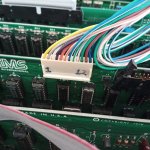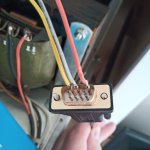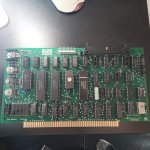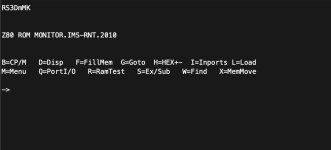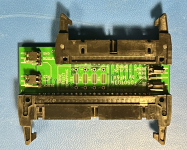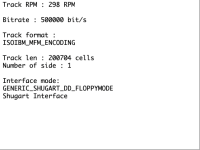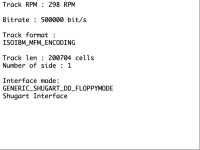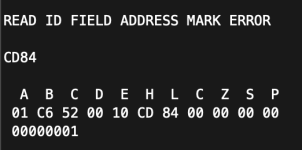twmiller
Experienced Member
Okay, so I think I'm slowly but surely making some headway on this, though not as far or as fast as I'd like. Today I used a little Arduino widget to test all of the 4116 memory on both memory cards and didn't find any errors. I also used a T48 USB EPROM burner widget to test all of the 74x logic ICs on the CPU card, the IO cards, the memory cards, and the floppy controller. In addition to verifying that the 74LS240 on the 450 CPU card that I discovered was bad and preventing the Z80 from releasing from reset, I also found a 74LS243 and a 74LS38 on one of the IO cards that was bad. I know a lot of people question (probably for good reason) the value of those testers, but a) the logic tester *did* find two bad chips, and b) it gave me a good excuse to pull and reseat all of the chips, and clean up the legs on a couple of chips that I discovered had some *serious* patina on them.
I also spent a bit of time and went over ALL of the jumpers carefully, to make sure I hadn't missed anything, and sure enough, when I mod'd the two IO cards to support 2732 chips, I didn't see that I had to cut the etches on JF, so it wasn't properly shunted for the 2732. Once all of this was done, I was now seeing the system power up, the memory parity light come on a just a bit, and then (with the IPLALL ROM in the IO card) go out. Further, if I *disable* the ROM on the 440 IO card, I do *not* see the memory parity light shut off. I think this is a good sign that the EPROM code is actually loading, and as you say, @new_castle_j, it then resets the parity error circuit and turns off the error light.
This is all the good news. I think it's a lot further along, and I'm (reasonably) more confident in the state of the hardware than I was. Having said this, it still does *not* poll the floppy drive. This might be because there's still something wrong with (or misconfigured) on the 401 floppy controller, it might be because the 401 floppy controller doesn't like the fd50to34 cable convertor widget I'm trying to use with it, and it might be because I have the jumpers on said-widget incorrectly set. It might be all of the above.
Thank you so much for the new version of Minimon x. It's not QUITE working, but it's at least providing the first output of ANY type I've seen (aside from a memory parity LED) from this system!
I've tried all combinations of both IO cards and memory cards. I believe I'm hooking it up correctly, based on the manual. I've got a FTDI USB to TTL serial cable with the pins broken out. Pins 1 through 5 on the 12 pin connector IO card are: TX, RX, CTS, RTS, and GND. From 1-5, I'm hooking up the FTDI cable as follows: RX, TX, RTS, CTS, and GND. (So like a null modem cable: flipping TX/RX and CTS/RTS.) I just get a little bit of gibberish when it connects, and then when I press one key I get a little more gibberish and then nothing else. It's acting like it's unhappy with the serial settings or baud rate, but based on the text of the monitor code, it should be set for 9600,N,8,1 which are the settings I'm using. (I did try a couple of other common baud rates to see if any of them worked, but had no luck.) I see the same thing in cu on the command line, Serial in macOS, and Tera Term on Windows.
I *think* this should work, but who knows. Tomorrow I'll try to wire up a proper serial port connector for it and try it with some of the other usb serial adapters I have. Like I said, SLOWLY making some progress, I think.
It's...alive?

I also spent a bit of time and went over ALL of the jumpers carefully, to make sure I hadn't missed anything, and sure enough, when I mod'd the two IO cards to support 2732 chips, I didn't see that I had to cut the etches on JF, so it wasn't properly shunted for the 2732. Once all of this was done, I was now seeing the system power up, the memory parity light come on a just a bit, and then (with the IPLALL ROM in the IO card) go out. Further, if I *disable* the ROM on the 440 IO card, I do *not* see the memory parity light shut off. I think this is a good sign that the EPROM code is actually loading, and as you say, @new_castle_j, it then resets the parity error circuit and turns off the error light.
This is all the good news. I think it's a lot further along, and I'm (reasonably) more confident in the state of the hardware than I was. Having said this, it still does *not* poll the floppy drive. This might be because there's still something wrong with (or misconfigured) on the 401 floppy controller, it might be because the 401 floppy controller doesn't like the fd50to34 cable convertor widget I'm trying to use with it, and it might be because I have the jumpers on said-widget incorrectly set. It might be all of the above.
Thank you so much for the new version of Minimon x. It's not QUITE working, but it's at least providing the first output of ANY type I've seen (aside from a memory parity LED) from this system!
I've tried all combinations of both IO cards and memory cards. I believe I'm hooking it up correctly, based on the manual. I've got a FTDI USB to TTL serial cable with the pins broken out. Pins 1 through 5 on the 12 pin connector IO card are: TX, RX, CTS, RTS, and GND. From 1-5, I'm hooking up the FTDI cable as follows: RX, TX, RTS, CTS, and GND. (So like a null modem cable: flipping TX/RX and CTS/RTS.) I just get a little bit of gibberish when it connects, and then when I press one key I get a little more gibberish and then nothing else. It's acting like it's unhappy with the serial settings or baud rate, but based on the text of the monitor code, it should be set for 9600,N,8,1 which are the settings I'm using. (I did try a couple of other common baud rates to see if any of them worked, but had no luck.) I see the same thing in cu on the command line, Serial in macOS, and Tera Term on Windows.
I *think* this should work, but who knows. Tomorrow I'll try to wire up a proper serial port connector for it and try it with some of the other usb serial adapters I have. Like I said, SLOWLY making some progress, I think.
It's...alive?


